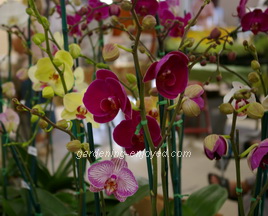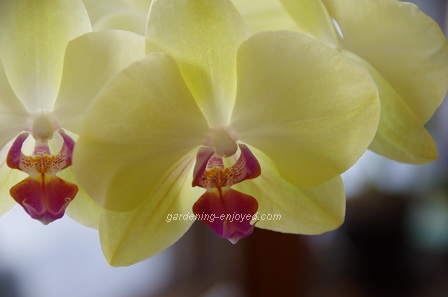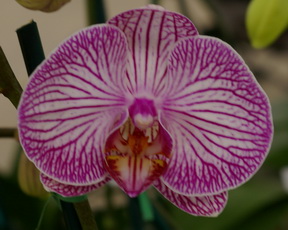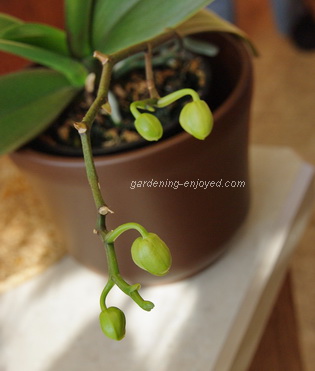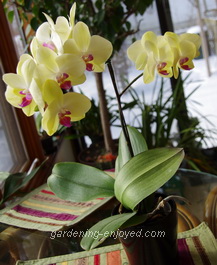Phalaenopsis Orchids
Wonderful Houseplants
Phalaenopsis orchids are rapidly becoming the standard flowering pot plant.
They are in every grocery store floral section or checkout and they seem to be there on a year round basis. They do deserve this status. They have wonderful exotic flowers in a wide range of colours and they stay in bloom for a few months. These Orchids are also quite easy to care for and with a little knowledge and effort most people can manage to get them to rebloom. I have also found that I can add to my collection by gathering up plants from those who have no interest in trying to rebloom them.
What Are They? Phalaenopsis are a group of tropical epiphytic Orchids that are native to Southeast Asia from the base of the Himalayas through the Philippines to Northern Australia. Knowing their origins provides us with lots of hints for their care. They do like to be outside in the summer but obviously cannot handle any frost. Being epiphytes, means that they grow attached to trees where they have their roots exposed to the air and where they are adjusted to lower light levels. Those
lower light levels are what makes them such great houseplants. Their epiphytic nature tells us to pot them in porous, well drained media and indicates why they are often sold in clear containers.
How Much Water? Phalaenopsis will always be happier if you provide them with too little water rather than too much water. In nature they get soaked when it rains but their roots just hang there in the humid air in between rains. If they are kept in a wet growing media the roots will rapidly rot and that’s the end of them. Loosely packed sphagnum moss or coconut husk chips or a combination of these is the best soil mix. If they are in moss then water them when they are dry on top and the pot is feeling quite light. Make sure they drain completely before putting them back into a decorative container. I tend to use Coconut chips and then I soak them in a bucket of water for a few moments to let the chips absorb their water and then drain them thoroughly. This is repeated when the chips feel quite dry. By soaking them I can also briefly immerse the leaves to remove any accumulating dust and dirt.
Fertilizer? Remember the phrase, weekly, weakly, and you will have a good idea of how to deal with their nutrient requirements. Obviously if you are not needing to water on a weekly basis then you adjust. Weakly, means something less then half the recommended rate. I use a general purpose soluble fertilizer, 20 - 20 - 20 during the spring and summer growing season and something like 5 - 15 - 5 in the fall and winter flowering period. Every third or fourth watering, use no fertilizer and make sure to water well to flush out any accumulating salts from the fertilizers.
Flowering? Most of us acquire one of these Phalaenopsis because we are enticed by the exotic blooms. The stores have them in bloom almost year round but that requires a greenhouse where you can control the temperature and light all year. They tend to bloom naturally in the autumn and early winter under the influence of cooler nights. Mine spend the summer outdoors in quite heavy shade and find their way back inside by mid September. They sit on the cool windowsills of the solarium and at some point they start to throw up new bloom stalks. When the blooms are finished in a few months you have a couple of choices. If it is a new plant, then the finished bloom stalk can be cut as close to its bottom as possible. If it is an older larger plant then you can often get some new flowers sooner by cutting the bloom stalk to about the second node and it will probably put out a branch at that point and keep on blooming.
What Now? If you receive a Phalaenopsis as a gift just sit back and enjoy the wonderful blooms, watering it occasionally. If you have an urge to exercise a latent green thumb then these are a great plant to try it with and you will probably be rewarded with even more exotic blooms. Don’t throw it out. You probably know someone like me that will take it in and nurture it and if they are really nice people they may give it back to you when it reblooms.
You can
search my entire site for answers to your gardening questions or sign up below for my free ezine.
Return from Phalaenopsis to Orchids main page
